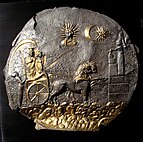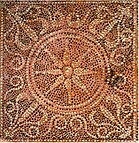
Greco-Bactrian Kingdom
The Greco-Bactrian Kingdom (Greek: Βασιλεία τῆς Βακτριανῆς, romanized: Basileía tēs Baktrianēs, lit. 'Kingdom of Bactria') was a Greek state of the Hellenistic period[2][3][4] located in Central Asia. Along with the Indo-Greek Kingdom in the Indian subcontinent, it was the easternmost part of the Hellenistic world. The kingdom was founded c. 256 BC by the Seleucid satrap Diodotus I Soter and lasted until its fall c. 120 BC.[a] It was ruled by the Diodotid dynasty, Euthydemid dynasty, and the Eucratid dynasty.
"Baktria" redirects here. For the historical region, see Bactria.
Kingdom of BactriaΒασιλεία τῆς Βακτριανῆς
Basileía tēs Baktrianēs
Basileía tēs Baktrianēs
Hellenistic Monarchy
Diodotus I (first)
Heliocles I (last)
256 BC
c. 120 BC
2,500,000 km2 (970,000 sq mi)
The Greco-Bactrian Kingdom covered much of present-day Afghanistan, Uzbekistan, Tajikistan, and Turkmenistan, and some parts of Kazakhstan, Pakistan and Iran. An extension further east, with military campaigns and settlements, may have reached the borders of the Qin State in 230 BC.[5][6] Its cities were among the largest and richest of antiquity; indeed, Bactria was known as the "land of a thousand cities."[7][8][9]
History[edit]
Origins[edit]
Bactria was inhabited by Greek settlers since the time of Darius I, when the entire population of Barca, in Cyrenaica, was deported to the region for refusing to surrender assassins.[10] Greek influence increased under Xerxes I, after the descendants of Greek priests who had once lived near Didyma (western Asia Minor) were forcibly relocated in Bactria,[11] and later on with other exiled Greeks, most of them prisoners of war. Greeks communities and language were already common in the area by the time that Alexander the Great conquered Bactria in 328 BC.[12]







![Bactrian phalera with military elephant carrying a howdah fortress manned by a soldier wearing a Macedonian helmet. 2nd century BCE, Hermitage Museum.[46][47][48]](http://upload.wikimedia.org/wikipedia/commons/thumb/1/1c/Bactrian_phalera_%28front%29_with_military_elephants%2C_2nd_century_BCE%2C_Hermitage_Museum%2C_Saint_Peterburg.jpg/143px-Bactrian_phalera_%28front%29_with_military_elephants%2C_2nd_century_BCE%2C_Hermitage_Museum%2C_Saint_Peterburg.jpg)
